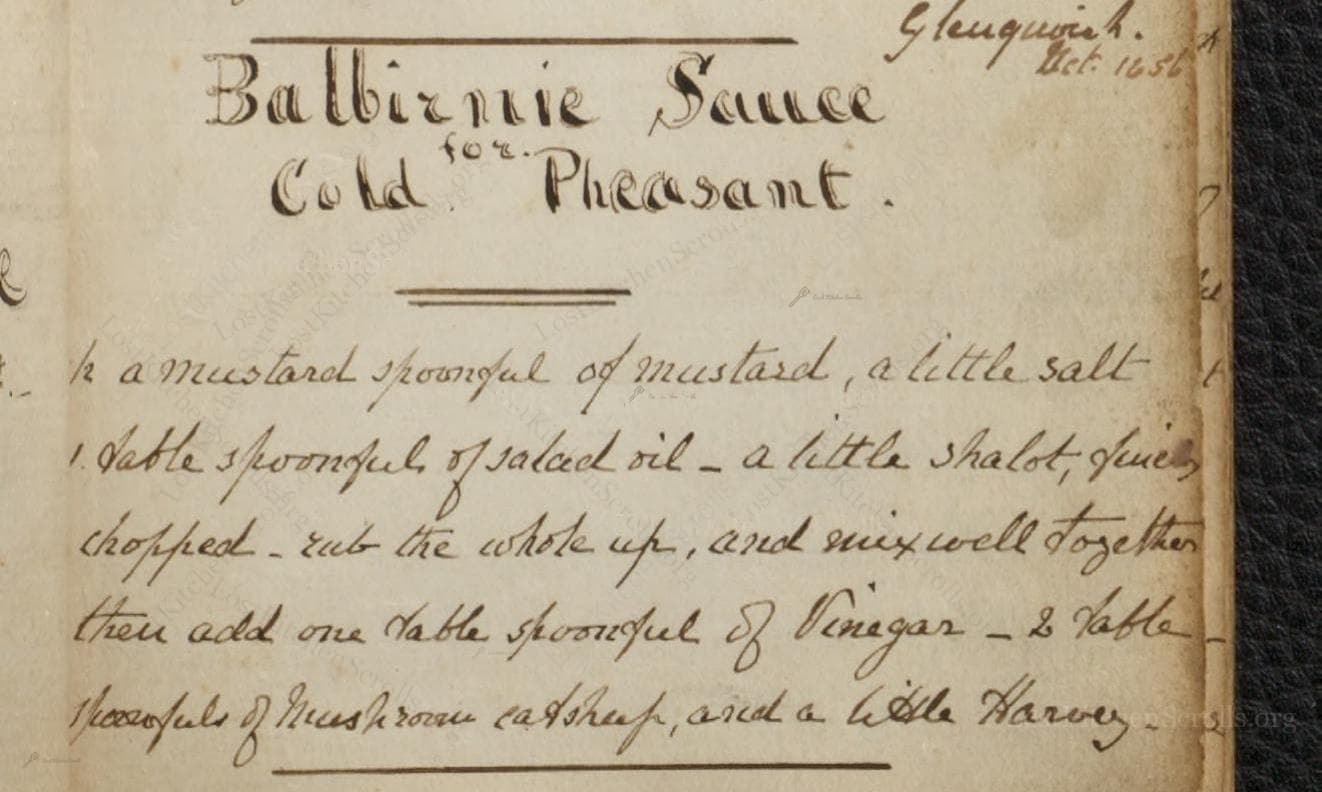
Balbirnie Sauce For Cold Pheasant
"Take a mustard spoonful of mustard, a little salt, 1 Table spoonful of salad oil - a little Shalot, fine chopped - rub the whole up, and mix well together then add one table spoonful of Vinegar - 2 Table spoonfuls of Mushroom catshup, and a little Harvey.—"
Note on the Original Text
The recipe is written in the brisk, shorthand style characteristic of 19th-century manuscript cookery, omitting precise measurements and relying on the cook’s intuition (e.g., 'a little salt', 'a little Shalot'). Quantities are described using household measures—'mustard spoonful', 'table spoonful'—which could vary according to the household but are roughly equivalent to modern teaspoons and tablespoons. Spelling varies between modern and period usages ('catshup' for 'ketchup', 'Shalot' for 'shallot'), reflecting both phonetic spellings and evolving vocabulary. The instructions presume familiarity with the ingredients and a fluid, improvisational approach to seasoning and assembling sauces.

Title
Recipe book of Charles Ellice, Colonel, 24th Regiment (1856)
You can also click the book image above to peruse the original tome
Writer
Charles Ellice, Colonel
Era
1856
Publisher
Colonel Charles Ellice
Background
A charming manuscript cookbook chronicling the culinary escapades of Colonel Charles Ellice during his globe-trotting military career, featuring recipes from Highland butter to yeastless bread, spicy curries, and even a dash of Victorian medicine—all penned alongside evocative ink sketches and a personal index.
Kindly made available by
McGill University
This recipe for Balbirnie Sauce comes from the mid-19th century manuscript cookbook of Colonel Charles Ellice, a British Army officer whose long career stationed him for years in India and Scotland. His cookbook is a treasure trove of both culinary and medical recipes, reflective of the needs and tastes of a well-heeled officer on imperial campaigns. It sheds light on the kinds of culinary improvisations and innovations popular at the time, showcasing accessible luxury and resourcefulness in using British condiments like mushroom ketchup and Harvey’s sauce. The recipe is designed as a tangy, robust sauce to complement cold game—especially pheasant—a nod to the tradition of serving leftover roast game cold and dressed for breakfast or luncheon tables in country houses and officers' messes.

In its time, this sauce would have been prepared in a small earthenware or ceramic bowl, using a mustard spoon (a small, shallow spoon) for measuring. Chopping the shallot would be done with a small kitchen knife on a wooden board. The mixing could be done with a spoon, a small whisk, or simply the back of the spoon to mash and blend ingredients together. No heating or cooking is required; it is a simple, cold-assembled condiment.
Prep Time
5 mins
Cook Time
0 mins
Servings
2
We've done our best to adapt this historical recipe for modern kitchens, but some details may still need refinement. We warmly welcome feedback from fellow cooks and culinary historians — your insights support the entire community!
Ingredients
- 0.18 ounces mustard (Dijon or English)
- 0.035 ounces fine sea salt
- 0.5 fl oz sunflower oil or light olive oil
- 0.07–0.1 ounces finely chopped shallot (about 1 teaspoon)
- 0.5 fl oz white wine vinegar
- 1 fl oz mushroom ketchup (or Worcestershire sauce plus soy sauce, equal parts as substitute)
- 0.17–0.34 fl oz Harvey’s sauce (or anchovy essence or extra Worcestershire sauce if unavailable)
Instructions
- Begin by measuring 1 heaping teaspoon (about 0.18 ounces) of Dijon or English mustard into a small mixing bowl, along with a pinch (about 0.035 ounces) of fine sea salt.
- Add 1 tablespoon (0.5 fluid ounces) of a neutral salad oil, such as sunflower or light olive oil.
- Finely chop a small amount (about 1 teaspoon, 0.07–0.1 ounces) of shallot and add to the mix.
- Using a spoon or small whisk, blend these ingrediants thoroughly to combine.
- Next, pour in 1 tablespoon (0.5 fluid ounces) of white wine vinegar, followed by 2 tablespoons (1 fluid ounce) of mushroom ketchup (or use a blend of Worcestershire sauce and soy sauce if mushroom ketchup is unavaiable).
- Finally, add a dash (1–2 teaspoons, about 0.17–0.34 fluid ounces) of Harvey’s sauce, or substitute with a mixture of anchovy essence or Worcestershire sauce if Harvey’s is unavailable.
- Mix all ingredients thoroughly until they form a cohesive sauce.
- Serve alongside cold, sliced pheasant or other cold game.
Estimated Calories
55 per serving
Cooking Estimates
This simple sauce takes only a few minutes to prepare and does not require any cooking. Each serving contains about 55 calories and the recipe makes enough for 2 people.
As noted above, we have made our best effort to translate and adapt this historical recipe for modern kitchens, taking into account ingredients nowadays, cooking techniques, measurements, and so on. However, historical recipes often contain assumptions that require interpretation.
We'd love for anyone to help improve these adaptations. Community contributions are highly welcome. If you have suggestions, corrections, or cooking tips based on your experience with this recipe, please share them below.
Join the Discussion
Rate This Recipe
Dietary Preference
Main Ingredients
Culinary Technique
Occasions

Den Bockfisch In Einer Fleisch Suppen Zu Kochen
This recipe hails from a German manuscript cookbook compiled in 1696, a time whe...

Die Grieß Nudlen Zumachen
This recipe comes from a rather mysterious manuscript cookbook, penned anonymous...

Ein Boudain
This recipe comes from an anonymous German-language manuscript cookbook from 169...

Ein Gesaltzen Citroni
This recipe, dating from 1696, comes from an extensive anonymous German cookbook...
Browse our complete collection of time-honored recipes



